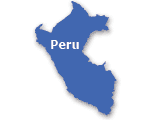ILAB in Peru
 |
Office of Child Labor, Forced Labor & Human Trafficking (OCFT) Technical Cooperation ProjectsClosed Projects
|
U.S. Department of Labor's Findings on the Worst Forms of Child Labor
This annual report, required by the Trade and Development Act of 2000, presents the findings of the Secretary of Labor with respect to trade beneficiary countries' implementation of international commitments to eliminate the worst forms of child labor.
- 2009 Report (PDF)
- 2008 Report (PDF)
- 2007 Report (PDF)
- 2006 Report (PDF)
- 2005 Report (PDF)
- 2004 Report (PDF)
- 2003 Report (PDF)
- 2002 Report (PDF)
- 2001 Report (PDF)
Labor Department Reports for the U.S. — Peru Trade Promotion Agreement
Per the Trade Act of 2002 [sections 2102(c)(5), 2102(c)(8) and 2102(c)(9)] and subsequent delegations of responsibilities that it creates, ILAB prepares for Congress three reports for every country with which the United States intends to establish a free trade agreement: a U.S. employment impact report, a report on the labor rights situation in our proposed partner country, and a report on laws governing exploitative child labor in the partner.
- United States Employment Impact Review of the United State-Peru Trade Promotion Agreemment (Report, September 2007)
- Peru Labor Rights Report (Report, September 2007)
- Peru Laws Governing Exploitative Child Labor Report (Report, September 2007)
For more information about the U.S.-Peru Trade Promotion Agreement, please visit the USTR Web site.
The Andean Trade Preference Act (ATPA)
The Andean Trade Preference Act (ATPA) was enacted in 1991 to combat drug production and trafficking in the Andean countries: Bolivia, Colombia, Ecuador and Peru. The program offers trade benefits to help these countries develop and strengthen legitimate industries. ATPA was expanded under the Trade Act of 2002 by the Andean Trade Promotion and Drug Eradication Act. Section 207 of the ATPA requires the Secretary of Labor, in consultation with other appropriate federal agencies, to undertake a continuing review and analysis of the impact of the implementation of the ATPA on U.S. labor. The legislation also directs the Secretary to submit an annual report to the Congress that presents a summary of the results of the review and analysis.
The United States – Peru Trade Promotion Agreement (PTPA) entered into force on February 1, 2009. The PTPA made permanent some benefits similar to the ones that Peru received under the ATPA and further liberalized trade with the United States in other areas. Because the PTPA did not entirely supplant the ATPA, Peru remained a designated beneficiary country of the ATPA until December 31, 2010. As a result, the 18th annual report is the last report in this series that includes Peru.
- 18th Annual Report (covers 2010) (PDF)
- 17th Annual Report (covers 2009) (PDF)
- 16th Annual Report (covers 2008) (PDF)
- 15th Annual Report (covers 2007) (PDF)
- 14th Annual Report (covers 2006) (PDF)
- 13th Annual Report (covers 2005) (PDF)
- 12th Annual Report (covers 2004) (PDF)
- 11th Annual Report (covers 2003) (PDF)
- 10th Annual Report (covers 2002)
- 9th Annual Report (covers 2001) (PDF)
- 8th Annual Report (covers 2000)
- 7th Annual Report (covers 1999)
- 6th Annual Report (covers 1998)
- 5th Annual Report (covers 1997)
- 4th Annual Report (covers 1996)
For more information about the ATPA, please visit the USTR Web site.